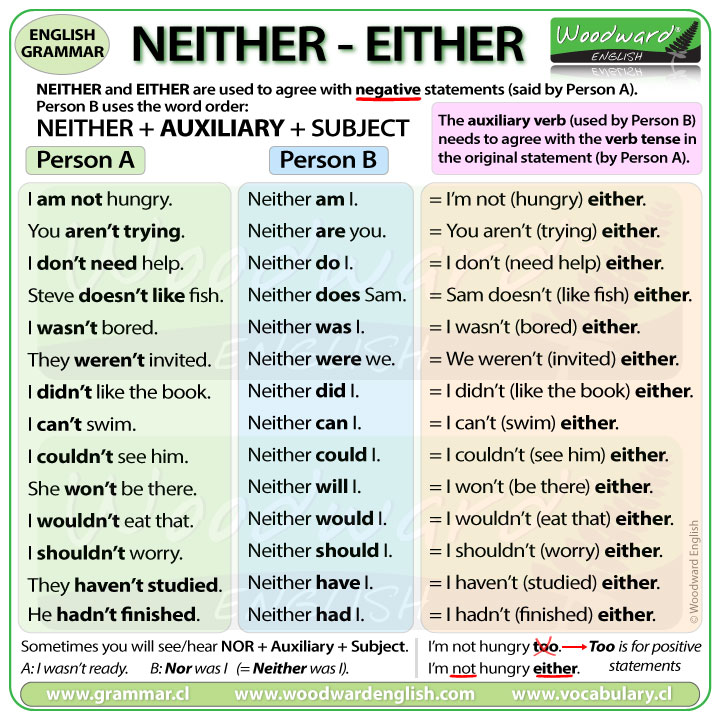NEITHER – EITHER – English Grammar Lesson
Person A: I am happy.
Person B: So am I.
So am I = I am happy too.
“I am happy.” is a positive sentence.
What happens when we have a negative sentence? For example:
- I am not happy.
We cannot respond with SO AM I because SO is only used to agree with positive sentences.
For negative sentences we use NEITHER so we would say:
- Neither am I.
Now, if the positive response of So am I means I am happy too.
What does Neither am I mean?
We do not say “I’m not happy too.”
TOO is used at the end of POSITIVE responses.
EITHER is used at the end of NEGATIVE responses.
So we can say:
- I’m not happy either.
In this case, Neither am I = I am not happy either.
Pronunciation of NEITHER
There are two ways to pronounce the word NEITHER.
Some people say /ˈnaɪðə(r)/
(sounds like nEYEther)
and other people say /ˈniːðə(r)/
(sounds like nEEther).
Both forms are correct.
(See our video to hear the pronunciation of NEITHER)
In American English you will hear both forms of pronunciation used.
You will also hear both forms of pronunciation used in British English.
Now let’s look at the following word order: NEITHER + Auxiliary + Subject
NEITHER + Auxiliary + Subject
The auxiliary verb needs to agree with the verb tense in the original statement or sentence.
In the first sentence “I am not happy.”
The verb is am which is a form of To Be in the present simple tense.
If the verb is in the present simple tense in the first sentence, then the response is in the same tense (the present simple tense) which becomes … Neither AM I.
So, the complete interaction is:
Speaker A: I am not happy.
Speaker B: Neither am I.
Neither am I = I’m not happy either.
Let’s look at a similar example:
- I wasn’t happy.
What tense is used here?
The past simple tense.
Since we have to use the same tense… what would the man’s response be to agree with the woman’s statement?
- Neither was I.
Both sentences are in the past simple tense.
- Person A: I wasn’t happy.
- Person B: Neither was I.
Now, all of these sentences have used TO BE… in the present simple and past simple tense.
What happens with other tenses?
Look at this sentence:
- I don’t want any more.
This sentence is in the present simple tense which means the response also needs to be in the present simple tense. However, it is not TO BE. It has the verb WANT.
Do we respond with: Neither want I ? NO!
We do NOT respond with the same verb we need to use an auxiliary verb.
We say:
- Neither do I.
The auxiliary verb for the present simple tense is Do or Does.
In this case we used DO because the subject is I …. Neither do I.
So the complete interaction is:
- Person A: I don’t want any more.
- Person B: Neither do I.
We use an auxiliary for all verbs except for TO BE and Modal verbs.
Let’s look at the same sentence in the past tense.
- I didn’t want any more.
This statement is in the past simple tense. This means for the response we need a past simple tense auxiliary verb.
How can we respond?
- Neither did I.
DID is the past simple tense auxiliary verb.
Neither did I = I didn’t want any more either.
So the complete interaction is:
- Person A: I didn’t want any more.
- Person B: Neither did I.
Let’s look at more ways of responding.
NEITHER and EITHER are used to show agreement with negative statements said by person A.
Person B uses the word order: NEITHER + AUXILIARY + SUBJECT.
The auxiliary verb used (by person B) needs to agree with the verb tense in the original statement (by Person A).
Look at these examples:
NEITHER with the Present Tense
Person A says:
- I am not hungry.
Person B needs to use the same tense so would respond with:
- Neither am I.
Neither am I = I’m not hungry either.
- You aren’t trying.
The response could be …
- Neither are you.
Neither are you = You are not trying either!
- I don’t need help.
- Neither do I.
Neither do I. = I don’t need help either.
- Steve doesn’t like fish.
You could say Neither do I … but let’s talk about another person, let’s use the name Sam. The response would be:
- Neither does Sam.
DOES because the auxiliary DOES is used for he/she/it.
Neither does Sam = Sam doesn’t like fish either.
NEITHER with the Past Tense
- I wasn’t bored.
This is the past simple tense of To Be (in negative form) so we need to respond with the same tense.
- Neither was I.
Neither was I. = I wasn’t bored either.
With the other form of To Be in the past simple tense…
- They weren’t invited.
Again, we need to use the past tense in the response. It becomes…
- Neither were we.
Neither were we. = We weren’t invited either.
- I didn’t like the book.
This is in the past simple tense and it is NOT to be. The negative auxiliary DIDN’T tells us the sentence is in the past tense so we also need to use the past tense auxiliary DID in the response. So the response could be:
- Neither did I.
Neither did I. = I didn’t like the book either.
So let’s quickly go through each of these again:
- Person A: I am not hungry.
Person B: Neither am I. - Person A: You aren’t trying.
Person B: Neither are you. - Person A: I don’t need help.
Person B: Neither do I. - Person A: Steve doesn’t like fish.
Person B: Neither does Sam. - Person A: I wasn’t bored.
Person B: Neither was I. - Person A: They weren’t invited.
Person B: Neither were we. - Person A: I didn’t like the book.
Person B: Neither did I.
Let’s see some more examples with some modal verbs and perfect tenses.
NEITHER with Modal Verbs
- I can’t swim.
This has the modal verb CAN in its negative form, so we also use the modal verb CAN in the response.
- Neither can I.
This means: I can’t swim either.
- We couldn’t see him.
If the first part has the modal verb COULD, then the response needs the modal verb could too.
- Neither could I.
This means: I could see the stars too.
- She won’t be there.
Here it uses the negative form of WILL which is WON’T. These are used to talk about the future, so our response needs to use WILL too.
- Neither will I.
This means: I won’t be there either.
- I wouldn’t eat that.
If the first statement has WOULDN’T, our response needs WOULD.
- Neither would I.
This means: I wouldn’t eat that either.
- I shouldn’t worry.
The negative form of the modal verb SHOULD is used. This means we also need to use SHOULD in the response.
- Neither should I.
This means: I shouldn’t worry either.
NEITHER with Perfect Tenses
-
- They haven’t studied.
Here we have the present perfect tense with the negative form of HAVE before the past participle. For our response, we need to use the auxiliary verb HAVE.
- Neither have I.
This means: I haven’t studied either.
- He hadn’t finished.
This is another perfect tense, this time the past perfect tense. So we need to use the same auxiliary (HAD) in our response.
- Neither had I.
This means: I hadn’t finished either.
So let’s quickly go through each of these again:
- Person A: I can’t swim.
Person B: Neither can I. - Person A: I couldn’t see him.
Person B: Neither could I. - Person A: She won’t be there.
Person B: Neither will I. - Person A: I wouldn’t eat that.
Person B: Neither would I. - Person A: I shouldn’t worry.
Person B: Neither should I. - Person A: They haven’t studied.
Person B: Neither have I. - Person A: He hadn’t finished.
Person B: Neither had I.
NOR + Auxiliary + Subject
Sometimes NOR is used instead of NEITHER
It has the same word order of:
Nor + Auxiliary + Subject
For example, if someone says:
- I wasn’t ready.
You can respond with:
- Nor was I
Nor was I = Neither was I.
Both forms are correct and mean the same thing.
If someone says:
- I didn’t want to go.
How could we respond this using NOR instead of NEITHER?
You can say:
- Nor did I
Nor did I = Neither did I.
Again, both forms are correct.
Summary Chart

